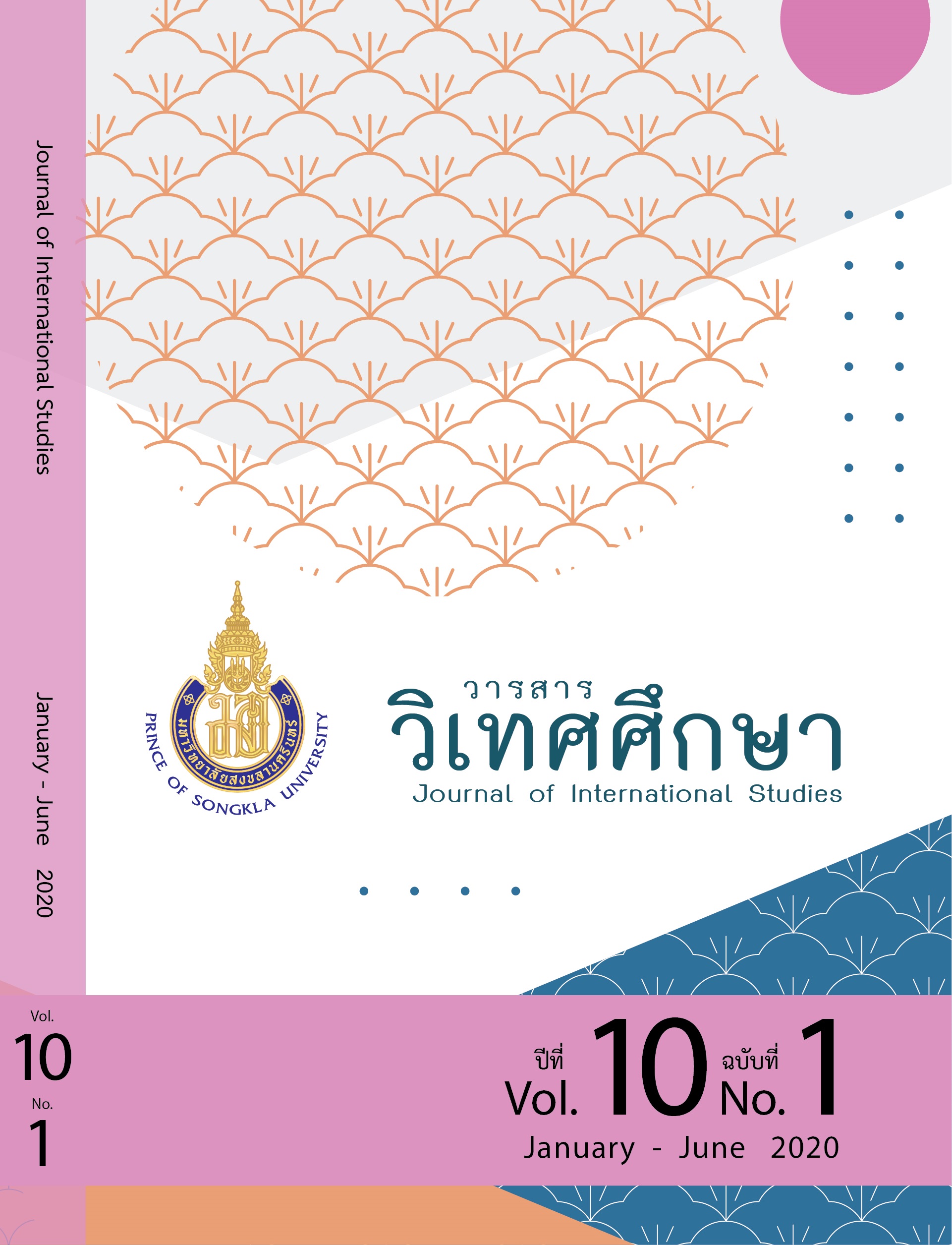อิทธิพลของ “Made in China 2025” ต่อนวัตกรรม พฤติกรรมการผลิตของจีน
Main Article Content
บทคัดย่อ
บทความนี้ถูกรวมเข้ากับแผน "Made in China 2025" ซึ่งเปิดตัวโดยสภาแห่งรัฐของจีนในปี 2558 เพื่อเปลี่ยนการผลิตของจีน ในบทความนี้นำข้อมูลพาเนลของบริษัทผู้ผลิตสาธารณะ A-share ในปี 2014 และ 2016 มาใช้พร้อมกับการนำรูปแบบความแตกต่างในความแตกต่าง (“DID”) มาใช้เพื่อตรวจสอบอิทธิพลที่แผนกำหนดต่อนวัตกรรมของบริษัท เท่าที่บริษัท ผู้ผลิตที่เกี่ยวข้องนั้นมีการเปิดเผยผ่านการศึกษาเชิงประจักษ์ว่าแผนแทรกแซงความสามารถในการสร้างสรรค์นวัตกรรมในระยะต่าง ๆ ของการพัฒนาผลิตภัณฑ์ นอกจากนี้เส้นทางนวัตกรรมยังเชื่อมโยงประสิทธิภาพของนวัตกรรมและเงินอุดหนุนทางการเงิน ในท้ายสุด บทความนี้ได้กำหนดข้อเสนอแนะจากมุมมองขององค์กรและรัฐบาล ในปี 2019 เป็นปีที่ห้านับตั้งแต่มีการดำเนินการตามแผน บทความนี้จะเป็นประโยชน์อย่างมากต่ออุตสาหกรรมการผลิตของจีนในการใช้ประโยชน์จากนโยบายเพื่อการปรับปรุงประสิทธิภาพในการพัฒนาผลิตภัณฑ์ของ บริษัท และการเร่งความเร็วในการพัฒนาอัจฉริยะขององค์กร บทความนี้ยังให้การตรวจสอบเพิ่มเติมของความสัมพันธ์ระหว่างการดำเนินนโยบายของรัฐบาลและประสิทธิภาพของนวัตกรรมขององค์กรและให้การอ้างอิงเพิ่มเติมสำหรับผู้ประกอบการจีนที่จะใช้พฤติกรรมนวัตกรรมอย่างมีประสิทธิภาพ
Article Details
ข้อความและความคิดเห็นที่แสดงในบทความ เป็นแนวคิดของผู้เขียน มิใช่ความรับผิดชอบของกองบรรณาธิการ และคณะผู้จัดทำแต่อย่างใด
บทความ ข้อมูล เนื้อหา รูปภาพ ฯลฯ ที่ได้รับการตีพิมพ์ในวารสารวิเทศศึกษา ถือเป็นลิขสิทธิ์ของวารสารวิเทศศึกษา หากบุคคลหรือหน่วยงานใดต้องการนำทั้งหมดหรือส่วนหนึ่งส่วนใดไปเผยแพร่ต่อหรือเพื่อกระทำการใด ๆ จะต้องได้รับอนุญาตเป็นลายลักษณ์อักษรจากวารสารวิเทศศึกษา ก่อนเท่านั้น
References
Atkeson, A., & Burstein, A. T. (2011). Policies to stimulate innovation. Economic Policy Paper, 11, 4-11.
Bronzini, R., & Piselli, P. (2016). The impact of R&D subsidies on firm innovation. Research Policy, 45(2), 442-457. doi.org/ 10.1016/j.respol.2015.10.008
Chen, H., & Na, C. (2018). A Study on Performance of Internal Control and R&D Subsidy. Management World, (12), 149-164. doi.org/10.3969/j.issn.1002-5502.2018.12. 013
Czarnitzki, D., Hanel, P., & Rosa, J.M. (2011). Evaluating the impact of R&D tax credits on innovation: A micro econometric study on Canadian firms. Research Policy, 40(2), 217-229. doi.org/10.2139/ssrn.651341
Dyer, J. H., & Singh, H. (1998). The relational view: cooperative strategy and sources of inter organizational competitive advantage. Academy of Management Review, 23(4), 660-679. doi.org/10.5465/AMR.1998.1255632
Ernst, D., & Kim, I. (2003). Global production networks, knowledge diffusion, and local formation. Research Policy, 31(2), 1417-1429. doi.org/10.1016/S0048-7333(02)00072-0
Fang, E. (2011). The effect of strategic alliance knowledge complimentarily on new product innovativeness in China. Organization Science, 22(1), 158-172. doi.org/ 10.1287/orsc.1090.0512
Guo, D., Guo, Y., & Jiang, K. (2016). Government-subsidized R&D and firm innovation: evidence from China. Research Policy, 45(6), 1129-1144. doi.org/10.1016/j.respol. 2016.03.002
Lazzarini, S. G. (2013). Strategizing by the government: Can industrial policy create firm-level competitive advantage? Strategic Management Journal, 36(1), 97-112. doi.org/ 10.1002/smj.2204
Mao, Q., & Xu, J. (2015). The Effect of Government Subsidy on Firms’ New Product Innovation: An Analysis Based on the Moderate Interval of Subsidy Intensity. China Industrial Economics, (6), 94-107.
Montmartin, B. & Herrera, M. (2015). Internal and external effects of R&D subsides and fiscal incentives: Empirical evidences using spatial dynamic panel models. Research policy, 44(5), 1065-1079.
Meuleman, M., & De Maeseneire, W. (2012). Do R&D subsidies affect SMEs’ access to external financing? Research Policy, 41(3), 580-591.
Podolny, J. M. (2001). Network as pipes and prisms of market. The American Journal of sociology, 107(1), 33-61
Peneder, M. (2008). The Problem of Private Under-investment in Innovation: A Policy Mind Map. Technovation, 28(8), 518-530.
Rao, N. (2012). Do Tax Credits Stimulate R&D Spending? The Effect of the R&D Tax Credit in its First Decade. Journal of Public Economics, 140(8), 1-12.
Wang, J. (2011). The measure of government R&D tax incentive intensity and its effect verification in China. Science Research Management, 32(9), 157-164.
Wen, Z., Zhang, L., Hou, J., & Liu, H. (2004). Intermediary effect test procedure and its application. Psychological Journal, (05), 614-620.
Xu, P., Zhang, M., & Zhai, X. (2020). The influence mechanism of R&D fiscal subsidy on regional patent output: an adjustable intermediary model. Journal of hunan university of science and technology (social sciences), 23(01), 75-83.
Yang, C.H., Huang, C.H., & Hou, T.C.T. (2012). Tax incentives and R&D activity: Firm-level evidence from Taiwan. Research Policy, 41(9), 1578-1588. doi.org/10.1016/j.respol.2012.04.006
Ye, K., & Zang, W. (2016). External Supervision and Classification Shifting of Business Expense. Management World, (1), 121-138.
Yang, Y., Yang, D., & Liu, A. (2014). Study on the Influence of Government Innovation Policy Effecting on Companies’ Innovation Behavior and Performance. Journal of HebeiUniversity of Economics and Business, (12), 47-53.
Zhou, J., & Li, J. (2017). Influence Mechanism of Government’s Innovation Policies on Firm’s Innovation Performance. Technology Economics, (1), 57-65. doi.org/10.3969/jissn. 1002-980X.2017.01.007

